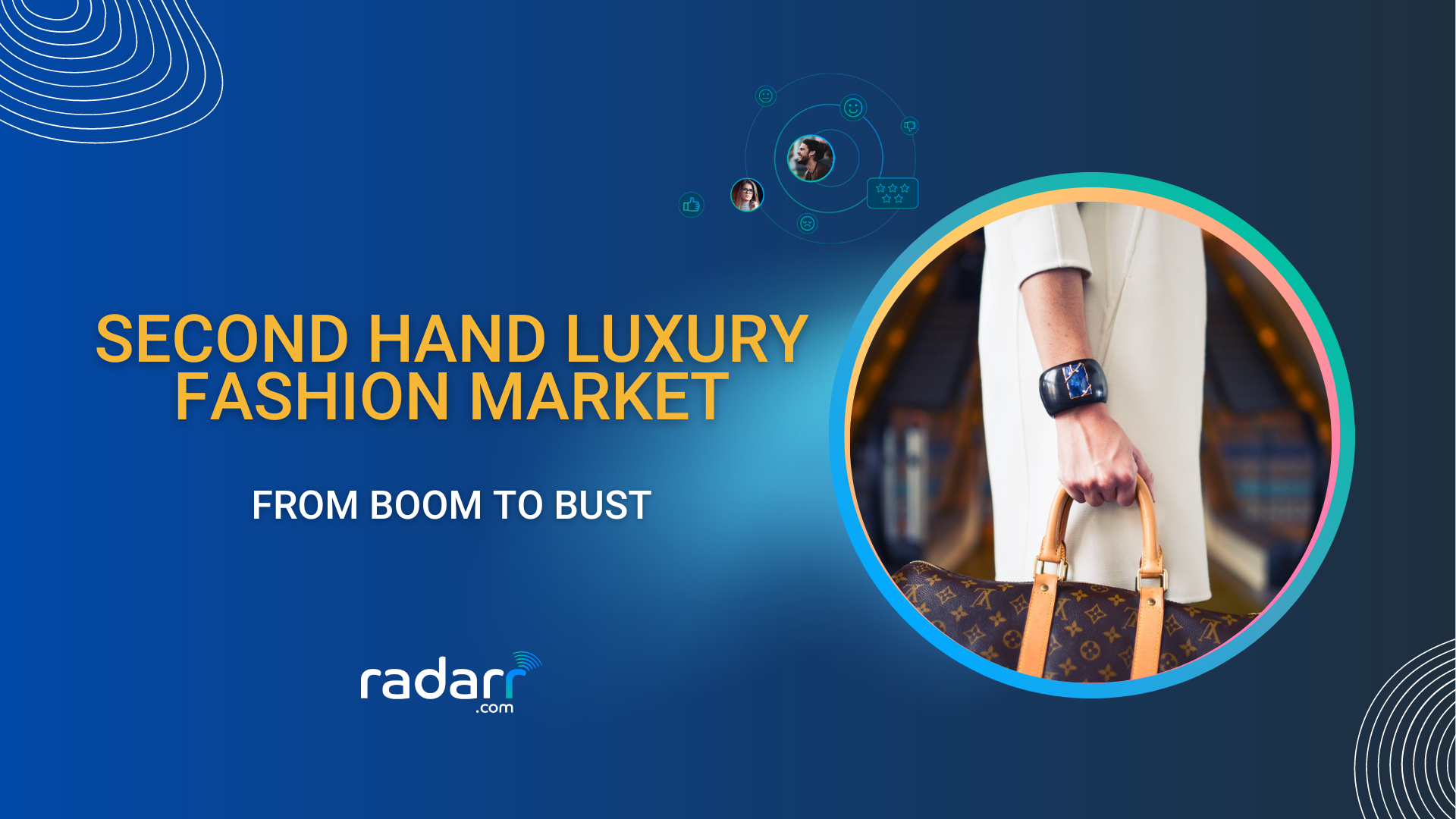In recent years, the secondhand luxury fashion industry experienced a meteoric rise, captivating both casual consumers and investors with the allure of sustainable luxury and cost-effective ownership of high-end items.
However, as with any rapidly expanding market, signs of a bubble have emerged, indicating that the once-booming sector may be on the verge of a significant downturn.
We have identified the several factors that contributed to this and the potential implications for consumers, investors, and the fashion industry.
Second Hand Luxury Fashion Conversations Over Time (Singapore, 2018 – 2023)
What caused the bubble to burst?
Saturation of the Market
The rapid proliferation of online marketplaces and resale platforms facilitated the growth of the secondhand industry. However, the sheer number of players and the overwhelming volume of available items eventually led to market saturation. With an abundance of similar products available, consumers faced difficulty differentiating between genuine investment opportunities and overpriced fashion pieces.
As the supply increased, the novelty of owning a secondhand luxury item diminished, and the exclusivity that once defined luxury was diluted. Consequently, prices stagnated, and many sellers struggled to find buyers willing to pay premium rates for their goods.
Growth of Secondhand Fashion Goods Retailer Posts (Singapore, 2018 – 2023)
Counterfeit and Authenticity Concerns
With the rise in popularity of secondhand luxury fashion, counterfeit products also flooded the scene. The prevalence of counterfeit fuxury fashion became a significant challenge for both consumers and industry players. For buyers, the risk of unknowingly purchasing a fake item eroded trust in the market, leading to apprehension and decreased demand.
Authentication processes were implemented by many resale platforms, but the task of verifying the authenticity of each item was laborious and not always foolproof. The presence of counterfeit goods further tainted the reputation of the industry, causing concern among potential buyers about the trustworthiness of the market as a whole.
It’s Still Difficult to Authenticate Counterfeit Goods Sold by Secondhand Retailers (Source)
Changing Consumer Behavior
As consumer trends are ever-changing, the initial enthusiasm for secondhand luxury fashion may have plateaued or even reversed. The post-pandemic era brought about shifts in consumer priorities, with many reevaluating their spending habits and placing greater emphasis on essential items and experiences over luxury possessions.
Additionally, the rise of the “buy now, wear now” mindset in fashion has diminished the appeal of investing in pre-owned luxury items that may not necessarily align with current fashion trends. This shift in consumer behavior has led to decreased demand and challenges in offloading certain secondhand luxury fashion, causing prices to plummet.
Mentions of Secondhand Luxury Fashion Purchase Intention Over Time (Singapore, 2018-2023)
The Uncertain Future
The bursting bubble of the secondhand luxury fashion market raises questions about its sustainability in the future. While the market may experience a period of correction, there is also the possibility that it will find a new equilibrium as consumer preferences evolve. For long-term investors, the market’s instability and uncertainty may have implications for their portfolios, as the value of certain luxury items may not hold up over time.
How have luxury brands adapted?
Chanel – Strengthening Brand Exclusivity
As the secondhand luxury fashion market experiences a downturn, Chanel has focused on strengthening its brand exclusivity. The brand’s commitment to producing limited quantities of each collection has long been a part of its strategy. By emphasizing scarcity and reducing the prevalence of its products on the secondary market, Chanel ensures that its items remain desirable and sought-after.
This approach bolsters Chanel’s image as an exclusive luxury brand, attracting discerning consumers who value rarity and craftsmanship. By remaining steadfast in its dedication to exclusivity, Chanel sustains its reputation as a symbol of prestige and elegance.
Chanel J12 Eclipse Watch – Only 55 Pieces Ever Made (Source)
Rolex – Certified Pre-Owned Program
Rolex has taken a proactive approach to the resale market by establishing its certified pre-owned program. Through this initiative, Rolex ensures that pre-owned watches bearing its name meet the brand’s strict standards of authenticity, quality, and condition.
By offering a certification process for its secondhand watches, Rolex gives consumers the confidence to purchase pre-owned pieces without hesitation. This move strengthens Rolex’s reputation for transparency and reliability, safeguarding its image in the competitive luxury watch market.
Rolex Certified Pre-Owned Program (Source)
Louis Vuitton – Innovative Collaborations and Unique Offerings
To cater to changing consumer preferences, Louis Vuitton has sought out innovative collaborations and introduced unique offerings. The brand collaborates with artists, designers, and creative minds from various industries, resulting in limited-edition collections that captivate both existing and new customers.
Louis Vuitton’s ability to strike a balance between its iconic heritage and fresh, innovative designs ensures that the brand remains relevant and appealing to diverse audiences, regardless of market fluctuations.
Louis Vuitton Collaboration with Yayoi Kusama (Source)
The industry’s future remains uncertain, and the true impact of the bursting bubble is yet to be fully realized. Nonetheless, it serves as a valuable lesson about the potential pitfalls of rapidly expanding markets and the importance of maintaining a balanced and sustainable approach to luxury consumption in an ever-evolving world.
As consumers and investors continue to navigate the shifting landscape, the secondhand luxury fashion industry must adapt and innovate to ensure its relevance and resilience in the years to come.
Author’s Note:
Daffi Ranandi is Radarr’s Associate Insights Manager, constantly monitoring global industry trends through Radarr’s digital intelligence platform. Ever since he purchased a counterfeit luxury bag for his wife by mistake, he got fascinated with taking a closer look at the authentic secondhand luxury fashion industry.












